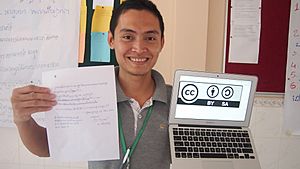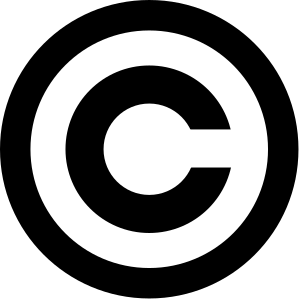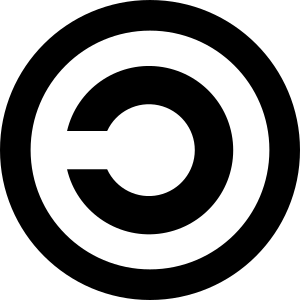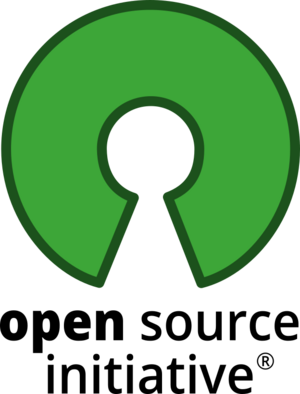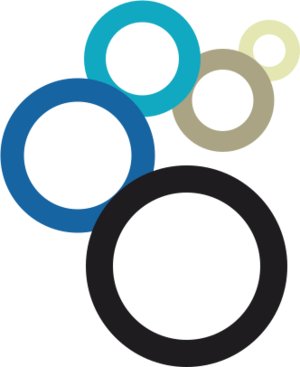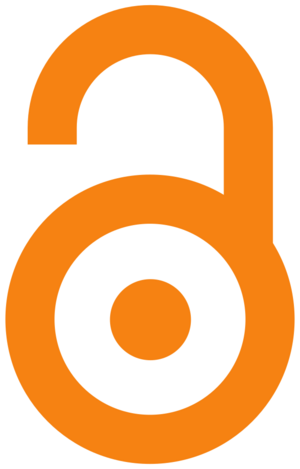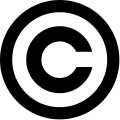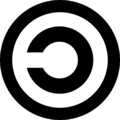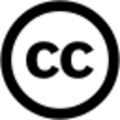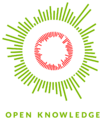Free content facts for kids
Free content means any creative work, like a book, a song, or a computer program, that has very few rules about how people can use, change, or share it. These works can be studied, used, copied, and changed by anyone for almost any reason, even for business. Free content includes things that are in the public domain (meaning no one owns the copyright anymore) and also copyrighted works that have special licenses allowing them to be used freely.
In most countries, laws usually give creators control over their work. So, for content to be "free," the creators must clearly say it's free. They usually do this by using a special permission statement called a free license. These licenses give users the freedom to use, study, change, or share the work. Sometimes, there are small rules, like needing to mention the original creator or keeping the same license for new versions. There are many standard licenses that let creators choose how their work can be used.
Contents
What is Free Content?
There are different ways people define "free content." Legally, it's a lot like "open content." Think of it like "free software" and "open-source software" – they're similar but have slightly different ideas behind them. Groups like the Open Knowledge Foundation say that "open" means the same as "free" when it comes to cultural works. For this kind of free or open content, they often suggest using specific Creative Commons licenses: CC BY, CC BY-SA, and CC0.
How Laws Affect Free Content
Copyright Rules
Copyright is a legal idea that gives the person who created something control over how it's copied and shared. In many places, this control lasts for a certain time. After that time, the work usually enters the public domain. Copyright laws try to balance the rights of creators with the rights of others to use and build on those works.
While a work is copyrighted, it can only be copied, changed, or shared publicly if the creator agrees, or if it's a "fair use" (like using a small part for a school project). Traditional copyright can make it hard to use content if you can't find the creator or if you want to make new things from it, like mashups. Even though free content seems like the opposite of copyright, free content licenses actually use copyright law to give people permission to use the work.
Public Domain Works
The public domain is like a big library of creative works where the copyright has ended or was never there. It also includes ideas and facts that can't be copyrighted. When a work is in the public domain, its creator has given up control over how it's used, or they no longer have that control. This means anyone can use, change, or share the work without any legal problems.
Copyleft: Sharing with Rules
Copyleft is a clever twist on the word "copyright." It's a way of using copyright law to make sure that copies and changed versions of a work stay free to share. The goal of copyleft is to let people reuse and change content created by an author.
Unlike works in the public domain, the author still owns the copyright. However, they give everyone permission to share and often change the work. Copyleft licenses usually require that any new works made from the original must also be shared under the same rules. A symbol often linked with copyleft is the copyright symbol turned the other way.
How Free Content is Used
Free content projects are found in many areas, like computer programs, books, music, pictures, and videos. Technology has made it much easier and cheaper for individuals or small groups to create and share materials widely.
Free Media
For media like text, audio, and video, free licenses from groups like Creative Commons help people share works with clear rules. Not all Creative Commons licenses are completely "free"; some might allow sharing but not changing, or not for business use. Since 2008, Creative Commons licenses that are truly free have a special badge saying they are "approved for free cultural works."
There are also online places that only have free material, like photos, clip art, music, and books. Wikipedia is one of the most famous places for user-uploaded free content on the internet. Most of Wikipedia's content is free, but some copyrighted material is used under "fair-use" rules.
Free Software
Free and open-source software (often called open source software) is a well-developed technology. Companies use it to provide services and technology to both everyday users and tech experts. It's easy to share, which helps smaller groups work together on projects. Some people believe that open source projects encourage teamwork and recognition, similar to scientific research, which can lower costs.

If enough people are interested in a software program, sharing it using peer-to-peer methods can lower the costs for developers. Since users help share the software, this method works well no matter how many people use it. Many places offer free services for hosting projects and sharing code.
Engineering and Design
The ideas behind free content are also used in engineering. Designs and engineering knowledge can be easily shared and copied. This helps reduce the costs of developing new projects. Open design ideas can be used in many areas, like phones, small-scale manufacturing, cars, and even farming.
New technologies allow people to build devices from existing plans. They use special software and manufacturing tools to turn information into physical objects.
Learning and Research
In academic work (like research papers), more and more works are becoming "open access." Open access means that research papers online are free to read and often have very few rules about how they can be used. Authors might choose open access to reach more people or because they believe in sharing knowledge freely.
Some universities, like the Massachusetts Institute of Technology (MIT), now make their research open access by default. For teaching, some universities, including MIT, offer free course materials online. This includes lecture notes, videos, and tutorials. These resources are shared with everyone on the internet.
Open content in education can also help reduce costs. Universities often pay a lot to subscribe to journals that publish research. But the articles are written and reviewed by academics for free. This has led to disagreements between publishers and universities over subscription prices.
Education for Everyone

Free and open content has created new ways for people to get higher education. Open content is a free way to learn that focuses on sharing knowledge and reusing learning materials. Many projects and groups, like OpenCourseWare and Khan Academy, promote learning through open content. Some universities, like MIT, Yale, and Tufts, offer their courses for free online.
There are also groups that encourage creating openly licensed textbooks. Examples include the University of Minnesota's Open Textbook Library, Connexions, OpenStax College, and Wikibooks.
Laws and Government Information
Every country has its own laws. In a country where laws are fair and open, laws are usually published as open content. This means they are generally free to access. However, there aren't always clear licenses for the text of each law. So, it's usually understood that you can use them freely. A few countries, like the UK, have clear licenses for their government documents. The rules of the Berne Convention (an international agreement on copyright) do not automatically protect the text of laws.
Countries often have websites where their laws are available. Examples include LexML Brazil and Legislation.gov.uk. Usually, a law is available in more than one official version, but the main one is published by a government newspaper or gazette.
The Story of Free Content
Early Ideas and the Open Content Project
The idea of using free software rules for other types of content started with Michael Stutz in 1997. He wrote about applying "copyleft" (a way to keep content free) to things that weren't software. The term "open content" was first used by David A. Wiley in 1998. He promoted it through the Open Content Project. This project described works that were licensed under the Open Content License and similar terms.
The Open Content Project website once said that open content was "freely available for modification, use and redistribution under a license similar to those used by the open-source / free software community." However, the Open Content License itself didn't allow charging money for content, which is something free and open-source software licenses do allow.
The 5Rs of Openness
Over time, "open content" came to mean a wider range of content without typical copyright limits. How "open" content is can be checked using the '5Rs Framework'. This framework looks at how much people can:
- Retain – make, own, and control copies (like downloading or saving).
- Reuse – use the content in many ways (like in a class or on a website).
- Revise – change or adapt the content (like translating it).
- Remix – combine the original or changed content with other open content to make something new.
- Redistribute – share copies of the original, your changes, or your remixes with others.
This broader definition makes open content different from open-source software, because open-source software must be available for business use. However, it's similar to how "open educational resources" are defined, which can include resources that aren't for business use.
What Came Next
In 2003, David Wiley announced that the Open Content Project was being replaced by Creative Commons and their licenses. Wiley then joined Creative Commons.
In 2005, the Open Icecat project started. It created and published product information for online stores using the Open Content License. This was popular in the tech world, which already liked open source ideas.
In 2006, a new project called the Definition of Free Cultural Works was created for free content. It was developed by Erik Möller, Richard Stallman, Lawrence Lessig, and others. The Wikimedia Foundation (which runs Wikipedia) uses this definition. In 2009, some Creative Commons licenses were officially marked as "Approved for Free Cultural Works."
Open Knowledge Foundation
Another important project is the Open Knowledge Foundation (OKF), started by Rufus Pollock in 2004. It's a non-profit group that helps promote and share open content and data around the world.
In 2007, the OKF created an Open Knowledge Definition for "content such as music, films, books; data be it scientific, historical, geographic or otherwise; government and other administrative information." By 2014, they defined "open" as meaning the same as "open/free" in other important definitions like the Open Source Definition.
The OKF also focuses on the public domain, open access, and easy-to-read open formats. They suggest using six specific licenses, including some from Creative Commons.
Images for kids
-
Unesco's Open Educational Resources logo
See also
 In Spanish: Contenido libre para niños
In Spanish: Contenido libre para niños
- Digital rights
- Open source
- Free education
- Free software movement
- Freedom of information
- Information wants to be free
- Open publishing
- Open-source hardware
- Project Gutenberg


